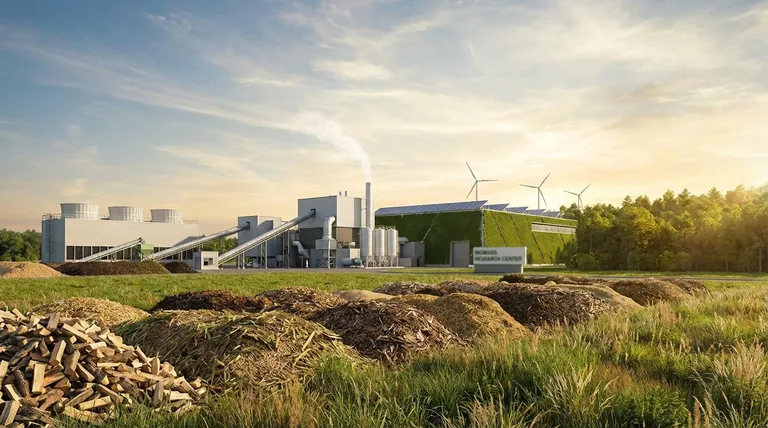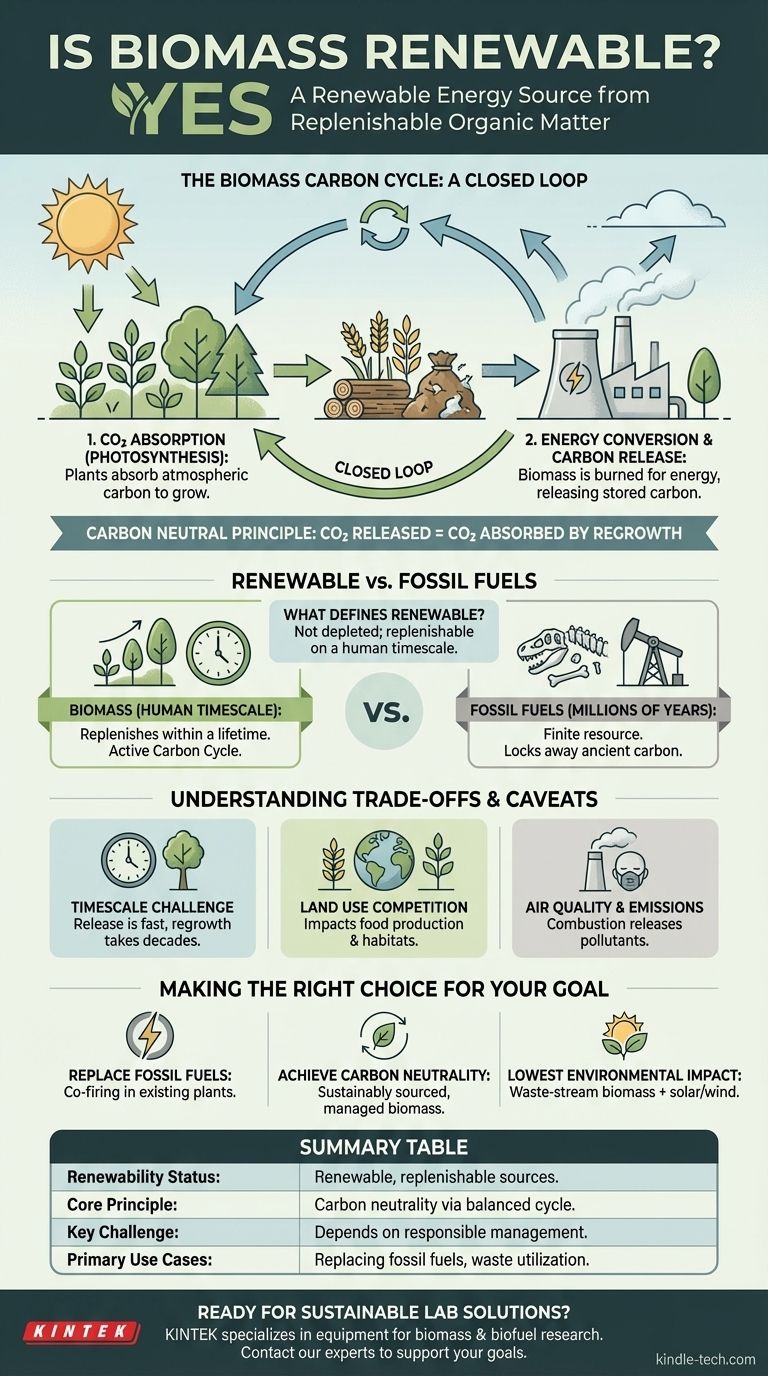In short, yes, biomass is a renewable energy source. It is classified this way because it is derived from organic matter—such as plants, wood, and waste—which can be replenished within a human lifetime. Unlike fossil fuels, which are finite, the sources for biomass can be regrown, making them a sustainable part of the energy cycle.
The renewability of biomass is fundamentally tied to the carbon cycle. While burning it releases carbon dioxide, this is the same carbon that was recently captured from the atmosphere by the plants as they grew, creating a theoretically closed loop.

What Defines a "Renewable" Source?
At its core, a renewable energy source is one that is not depleted when used or can be replenished on a human timescale. This stands in direct contrast to non-renewable sources like coal, oil, and natural gas.
The Time Horizon of Replenishment
The key differentiator is time. Wind and solar energy are renewable because the sun continues to shine and the wind continues to blow.
Biomass is renewable because we can grow more trees, crops, and other organic matter. The cycle of growth and harvest is what makes it a perpetually available resource, provided it is managed responsibly.
How Biomass Differs from Fossil Fuels
Fossil fuels are also derived from ancient organic matter, but their formation process takes millions of years.
When we burn fossil fuels, we are releasing carbon that has been locked away for eons, adding new carbon to the atmosphere. When we burn biomass, we are releasing carbon that was part of the active, contemporary carbon cycle.
How the Biomass Carbon Cycle Works
Understanding the carbon cycle is essential to understanding why biomass is considered renewable. The process is a continuous loop of absorption and release.
Step 1: Carbon Absorption Through Photosynthesis
As plants and trees grow, they absorb carbon dioxide (CO2) from the atmosphere. They use the energy from the sun to convert this CO2 and water into carbohydrates, which form the physical structure of the plant.
This process effectively removes carbon from the air and stores it in the biomass.
Step 2: Energy Conversion and Carbon Release
When this biomass is harvested and converted into energy—typically through burning—the stored energy is released.
This conversion process also releases the stored carbon back into the atmosphere as CO2, where it can then be reabsorbed by new plant growth, restarting the cycle.
The Principle of Carbon Neutrality
If the rate at which we harvest and use biomass is balanced by the rate at which new biomass is grown, the process is considered carbon neutral.
Essentially, the CO2 released during energy conversion is offset by the CO2 absorbed by regrowth. This balance is what makes biomass a sustainable alternative to fossil fuels.
Understanding the Trade-offs and Caveats
While renewable, biomass energy is not without its challenges. True sustainability depends entirely on responsible management and sourcing.
The Critical Factor of Timescale
A major challenge is the difference in time between carbon release and recapture. Burning a tree releases its stored carbon in minutes, but growing a replacement tree to absorb an equivalent amount of carbon can take decades.
If biomass is consumed faster than it is regrown, it becomes a net contributor to atmospheric CO2, undermining its "renewable" status.
Land Use and Competition
Devoting large areas of land to growing "energy crops" for biomass can have significant consequences.
This can compete with land needed for food production, potentially impacting food prices and availability. It can also lead to deforestation or the destruction of natural habitats if not managed sustainably.
Emissions and Air Quality
The combustion of biomass, especially wood, can release other pollutants besides CO2, including nitrogen oxides (NOx), volatile organic compounds (VOCs), and particulate matter.
These emissions can impact local air quality and human health, requiring modern filtration and combustion technologies to mitigate.
Making the Right Choice for Your Goal
Biomass is a tool with specific strengths and weaknesses. Its effectiveness depends entirely on the strategic goal it is intended to serve.
- If your primary focus is replacing fossil fuels with existing infrastructure: Biomass can be co-fired in existing coal plants, offering a direct and relatively quick way to reduce reliance on non-renewable resources.
- If your primary focus is achieving true carbon neutrality: You must insist on biomass sourced from sustainably managed forests, agricultural residues, or municipal waste to ensure the carbon cycle remains in balance.
- If your primary focus is the lowest possible environmental impact: Using waste-stream biomass (like garbage or forestry byproducts) and complementing it with zero-emission renewables like solar and wind creates the most balanced and sustainable energy portfolio.
Ultimately, the sustainability of biomass is not inherent in the material itself, but in the human systems we design to manage it.
Summary Table:
| Key Aspect | Description |
|---|---|
| Renewability Status | Renewable, due to replenishable organic sources (plants, waste). |
| Core Principle | Carbon neutrality via a balanced cycle of absorption and release. |
| Key Challenge | Sustainability depends on responsible sourcing and management. |
| Primary Use Cases | Replacing fossil fuels, utilizing waste streams, achieving carbon neutrality. |
Ready to implement sustainable energy solutions in your lab? KINTEK specializes in providing the lab equipment and consumables needed for advanced biomass and biofuel research. From precise analysis tools to efficient processing equipment, we support your sustainability goals. Contact our experts today to find the right solutions for your laboratory's needs.
Visual Guide

Related Products
- Electric Rotary Kiln Small Rotary Furnace Biomass Pyrolysis Plant
- Electric Rotary Kiln Small Rotary Furnace for Activated Carbon Regeneration
- Electric Rotary Kiln Continuous Working Small Rotary Furnace Heating Pyrolysis Plant
- Hybrid High Energy Vibratory Ball Mill for Lab Use
- Electric Rotary Kiln Pyrolysis Furnace Plant Machine Calciner Small Rotary Kiln Rotating Furnace
People Also Ask
- What are the different types of pyrolysis machines? Choose the Right System for Your Output
- Is pyrolysis viable? A Guide to Economic, Technological, and Environmental Success
- What are the reactions involved in pyrolysis of biomass? Unlock the Chemistry for Tailored Bio-Products
- What is the process of biomass fast pyrolysis? Turn Biomass into Bio-Oil in Seconds
- What are the products of pyrolysis of biomass? Unlock Bio-Char, Bio-Oil, and Syngas




